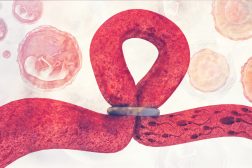Table of Contents
Definition
noun
plural: cyclic guanosine monophosphates
(biochemistry) A cyclic form of guanosine monophosphate (chemical formula: C10H12N5O7P) that serves as a second messenger for signal transduction at the cellular level
Details
Overview
Cyclic guanosine monophosphate (cGMP) is a form of guanosine monophosphate (GMP). GMP is a nucleotide composed of guanine, ribose and a phosphate group. It is an ester of phosphoric acid and the nucleoside guanosine. GMP is one of the nucleotides that when phosphorylated into guanosine triphosphate (GTP) may serve as a constituent of a nucleic acid (particularly, RNA). GTP forms a chain with other monomeric nucleotides. However, cGMP does not form a chain. Rather, it occurs as a cyclic structure, particularly esterified to a sugar moiety in both 3′- and 5′- positions.
Characteristics
Guanosine monophosphate (GMP) is a nucleoside monophosphate in being comprised of a ribonucleoside and one phosphate group. It means it has a ribose as its sugar and one phosphate group attached. Its nucleoside contains a purine base, i.e. guanine attached to the ribose sugar. It has only one phosphate group attached to the nucleoside.
Common biological reactions
Common biological reactions
cGMP is derived from GTP. The process is catalyzed by guanylate cyclase, a lyase enzyme. The activity of the enzyme is influenced by calcium levels. It becomes activated in response to a low intracellular calcium level and inhibited when the latter is high. Guanylate cyclase that is bound to the cell membrane is typically activated upon reacting with peptide hormones (e.g. atrial natriuretic factor). Nitric oxide can also act as an activator, particularly of soluble guanylate cyclase. When active, the enzyme is prompted to synthesize cGMP, i.e. by converting GTP into cGMP.
As for catabolism, cGMP is degraded by hydrolyzing cGMP into 5′-GMP through the action of phosphodiesterases (PDEs). PDE 1, PDE 2, PDE 3, PDE 10 and PDE 11 degrade both cGMP and cyclic adenosine monophosphate (cAMP) whereas PDE 5, PDE 6, and PDE 9 are cGMP-specific. In the photoreceptors of mammalian eye, for instance, PDE is activated by the presence of light, and as a result, degrades cGMP. This is essential especially during phototransduction.
Biological functions
cGMP is a second messenger similar to cAMP. It has been found to activate certain intracellular protein kinases when peptide hormones bind to the cell membrane and activate cGMP. For instance, cGMP binds to the regulatory units of protein kinase G. The binding causes the activation of the catalytic units of protein kinase G initially blocked by the regulatory units. As a result, the activated protein kinase is now capable of phosphorylating its substrates.
Apart from being involved in the intracellular signal transduction with certain kinases, cGMP is presumed to have a role in the regulation of the passage of calcium ions into the cell. cGMP has been found to keep the cGMP-gated channels in the cell membrane open thereby permitting the influx of calcium into the cell.1 cGMP also has a regulatory role in sodium ion channels. In particular, the sodium ion channels in the photoreceptors of the mammalian eye are cGMP-gated as well. The presence of light activates certain phosphodiesterases that degrade cGMP. Without cGMP, the cGMP-gated sodium channels would thereby close resulting in the reduced influx of both Na+ and Ca2+ ions. This, in turn, reduces the dark current causes the photoreceptor to hyperpolarize and reduces the release of glutamate. This would then reduce the inhibition of retinal nerves, which means the excitation of retinal nerves. This ultimately leads to visual information being relayed to the brain.
At large, cGMP has a role in ion channel conductance, smooth muscle tissue relaxation, vascular smooth muscle vasodilation (and the subsequent increased blood flow), insulin secretion, peristalsis, vocal tone, visual phototransduction, and cellular apoptosis, and glycogenolysis.
Supplementary
Abbreviation(s)
- cGMP
- cyclic GMP
Chemical formula
IUPAC
- 2-amino-9-(1S,6R,8R,9R)-3,9-dihydroxy-3-oxo-2,4,7-trioxa-3λ5-phosphabicyclo4.3.0nonan-8-yl-3H-purin-6-one
Synonyms
Further reading
See also
Reference
- Sakurai K., Chen J., &Kefalov V. (2011). “Role of guanylate cylcase modulation in mouse cone phototransduction”. The Journal of Neuroscience. 31(22): 7991–8000. doi:10.1523/jneurosci.6650-10.2011
© Biology Online. Content provided and moderated by Biology Online Editors







